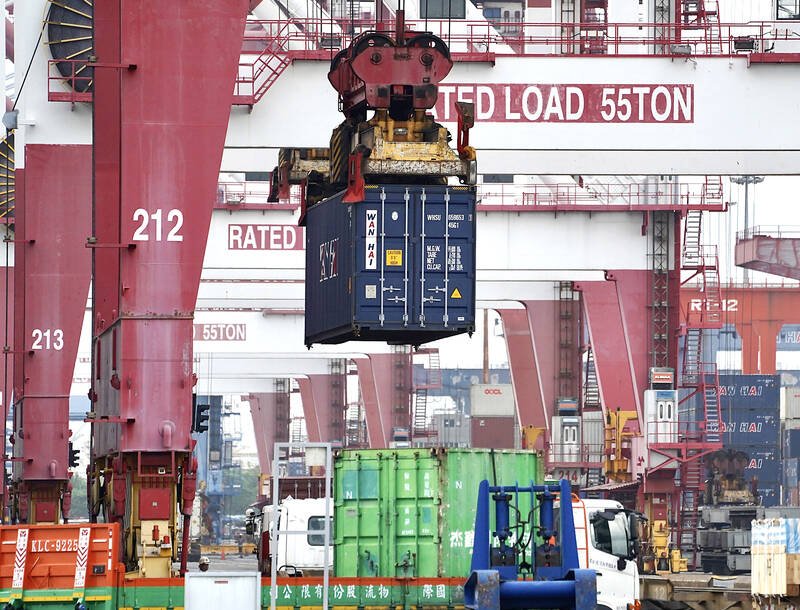Exports last month squeezed a 1.3 percent increase from a year earlier to US$31.43 billion, the second-highest for the same month despite holiday disruptions, as strong demand for artificial intelligence (AI) applications offset declines in all other product categories, the Ministry of Finance said yesterday.
The positive showing beat the ministry’s forecast of a retreat linked to fewer working days over the Lunar New Year and weak seasonality for technology products this quarter.
Stripping out the holiday effect, exports grew 9.7 percent in the first two months to US$68.62 million, driven single-handedly by information and communications technology (ICT) products, Department of Statistics Director-General Beatrice Tsai (蔡美娜) said.

Photo: CNA
“Exports have expanded for four months in a row, suggesting an evident, but uneven recovery,” Tsai said.
Broad-based recovery will have to wait for a few more months, likely in May or June, she said.
Tsai’s guarded optimism came after exports of electronics shrank 10.4 percent from a year earlier, while shipments of semiconductors fell 9.9 percent, the ministry’s monthly report showed.
Furthermore, shipments of optical and precision devices plunged 32.1 percent, while non-technology products posted decreases of between 8.6 percent and 26.4 percent, it found.
Taiwan is home to the world’s leading suppliers of electronics used in smartphones, personal computers, high-performance computing chips and vehicles, among other applications.
At the same time, exports of textile products and transportation tools weakened 16.8 and 16.3 percent respectively.
Tsai attributed the poor showings to a supply glut, as well as shipping schedule adjustments due to the Red Sea crisis.
Shipments of ICT products proved the only bright spot and more than doubled on the back of fast-growing AI investments and applications, Tsai said.
Scores of Taiwanese firms are responsible for supplying AI servers, graphics processing units and other critical components, in addition to advanced chips.
Things would improve in May and June, as the current quarter is the slowest season of the year, Tsai said.
Following the holiday disruptions, exports would expand by 9 to 13 percent, she said.
Imports tumbled a steeper 17.8 percent to US$23.55 billion, giving Taiwan a trade surplus of US$7.89 billion, 2.3 times the value a year earlier, the report found.
Imports of capital equipment slumped 44.3 percent, as local firms viewed the ongoing recovery as moderate and were cautious about capital spending, Tsai said.
By geographic breakdown, the US overtook ASEAN markets as the second-largest export destination with a 22.6 percent share, Tsai said, as AI demand stemmed mainly from US clients.
China remained Taiwan’s largest export partner, but its share fell to 29.2 percent as a result of domestic and external economic struggles, she said.
China is taking a hit from a property bubble at home and technology competitions and trade disputes with the US, the official said.

The US dollar was trading at NT$29.7 at 10am today on the Taipei Foreign Exchange, as the New Taiwan dollar gained NT$1.364 from the previous close last week. The NT dollar continued to rise today, after surging 3.07 percent on Friday. After opening at NT$30.91, the NT dollar gained more than NT$1 in just 15 minutes, briefly passing the NT$30 mark. Before the US Department of the Treasury's semi-annual currency report came out, expectations that the NT dollar would keep rising were already building. The NT dollar on Friday closed at NT$31.064, up by NT$0.953 — a 3.07 percent single-day gain. Today,

‘SHORT TERM’: The local currency would likely remain strong in the near term, driven by anticipated US trade pressure, capital inflows and expectations of a US Fed rate cut The US dollar is expected to fall below NT$30 in the near term, as traders anticipate increased pressure from Washington for Taiwan to allow the New Taiwan dollar to appreciate, Cathay United Bank (國泰世華銀行) chief economist Lin Chi-chao (林啟超) said. Following a sharp drop in the greenback against the NT dollar on Friday, Lin told the Central News Agency that the local currency is likely to remain strong in the short term, driven in part by market psychology surrounding anticipated US policy pressure. On Friday, the US dollar fell NT$0.953, or 3.07 percent, closing at NT$31.064 — its lowest level since Jan.

The New Taiwan dollar and Taiwanese stocks surged on signs that trade tensions between the world’s top two economies might start easing and as US tech earnings boosted the outlook of the nation’s semiconductor exports. The NT dollar strengthened as much as 3.8 percent versus the US dollar to 30.815, the biggest intraday gain since January 2011, closing at NT$31.064. The benchmark TAIEX jumped 2.73 percent to outperform the region’s equity gauges. Outlook for global trade improved after China said it is assessing possible trade talks with the US, providing a boost for the nation’s currency and shares. As the NT dollar

PRESSURE EXPECTED: The appreciation of the NT dollar reflected expectations that Washington would press Taiwan to boost its currency against the US dollar, dealers said Taiwan’s export-oriented semiconductor and auto part manufacturers are expecting their margins to be affected by large foreign exchange losses as the New Taiwan dollar continued to appreciate sharply against the US dollar yesterday. Among major semiconductor manufacturers, ASE Technology Holding Co (日月光), the world’s largest integrated circuit (IC) packaging and testing services provider, said that whenever the NT dollar rises NT$1 against the greenback, its gross margin is cut by about 1.5 percent. The NT dollar traded as strong as NT$29.59 per US dollar before trimming gains to close NT$0.919, or 2.96 percent, higher at NT$30.145 yesterday in Taipei trading